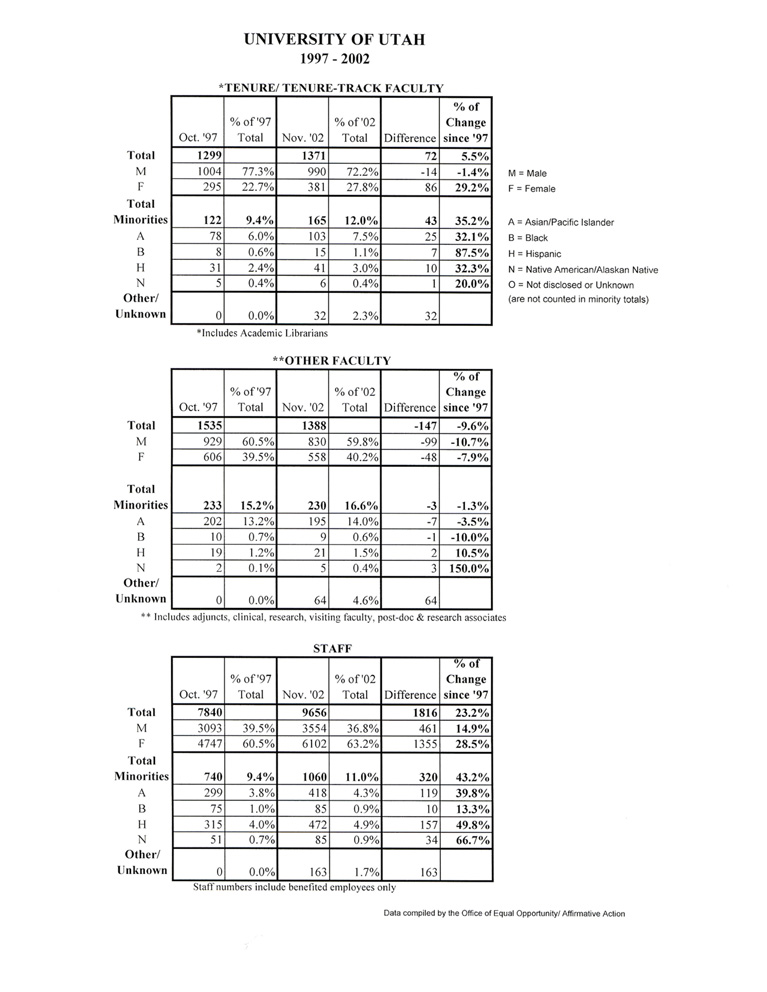
December 02, 2002 — When Bernie Machen became president of the University of Utah nearly five years ago, he saw increasing diversity on campus as fundamental to the success of the University and committed himself to this goal.
Now, according to figures recently released by the U’s Office of Equal Opportunity and Affirmative Action, progress is being made as diversity is increasing among students, faculty and staff at the U. Specific initiatives, such as diversity programming, the Utah Opportunity Scholarship and the University/Neighborhood Partners project, are credited, in part, for some of the changes.
Over the last five years, the number of minority students attending the U has increased from 1,692 to 2,093, or 23.7 percent. Currently, Asian American and Pacific Islander, African American, Hispanic/Latina-o and American Indian students constitute 7.5 percent of the student population, as compared to 6.7 percent in the fall of 1997.
“We are very pleased that these numbers reflect the U’s efforts to attract students and faculty of different ages, races, beliefs, genders and ethnicities,” notes Machen.
Over the last five years the number of foreign students attending the University has increased 20.7 percent, from 1,529 to 1,845. Currently, foreign students, who come from 106 different countries, constitute 6.6 percent of the student body at the U.
Since 1997 the number of tenure/tenure track minority faculty at the U has increased from 122 to 165, or by 35.2 percent. (They currently constitute 12 percent of all tenure/tenure track faculty.) Since 1997 the tenure/tenure track female minority faculty has increased by 29.2 percent-from 295 in 1997 to 381 in 2002. The male minority tenure/tenure track faculty dropped 1.4 percent-from 1,004 in 1997 to 990 in 2002. While there was a slight decrease in the number of minority auxiliary faculty-from 233 in 1997 to 230 in 2002, minority auxiliary faculty now constitute 16.6 percent of the total, as compared to 15.2 percent in the fall of 1997. Benefits-eligible minority staff increased from 740 in 1997 to 1,060 in 2002-or 43.2 percent-in the last five years. (See charts below).
“While there is still much work to be done, the University has made great strides in reaching out to and recruiting underrepresented students or those who may face limited access to educational and career opportunities,” says Suzanne Espinoza, director of student recruitment for the U.
Espinoza notes that University representatives visit local high schools through an ambassador program to meet with diversity students and encourage their enrollment at the U. “We have undergraduate students from ethnic minority groups who meet with students to discuss the importance and value of higher education and the specifics about how students can plan for it. We also work with community leaders to identify eligible students who need to be advised about admission,” she says.
Karen Dace, associate vice president for diversity at the University, also acknowledges the U’s ongoing efforts to reach students who have traditionally been underrepresented. The increase in numbers of minority students may be partly attributable, she says, to the “increased campus-wide awareness of and validation of diverse individuals and groups,” also evidenced in a number of Machen’s initiatives.
Over the past two years Machen has focused on a number of new diversity projects, including increased minority recruitment, scholarship and community outreach initiatives.
In February 2001, Machen announced the formation of The Utah Opportunity Scholarship, which awards 20 underrepresented students in the Salt LakeValley with four-year, $5,000-per-year scholarships and also connects them one-on-one to faculty mentors who will guide them through their university experience. Last year, Machen established the University/Neighborhood Partners project to better link the U to Salt Lake’s west side and to the rest of Salt Lake City. He celebrated the opening of the new ASUU Child Care Center as well as the re-opening of the newly renovated interfaith Post Chapel in Fort Douglas, which he designated as a place of meditation and worship for those of all faiths. (It is rare for a public university to include a chapel of this kind.) In April, Machen attended and spoke at the opening of the University’s Lesbian, Gay, Bisexual, and Transgender (LGBT) Resource Center, which provides information and support to students-and their families and friends.
Machen says the University will continue to implement diversity programming-in curriculum, through campus events and through support of diverse student organizations. (Currently U students have opportunities for involvement in nearly 200 different student organizations.)
Says Machen: “The University’s role is to provide a rich, multidimensional education; one that includes not only diversity in thought and discourse, but diversity of people and range of experiences.”
###
UNIVERSITY OF UTAH
1997 – 2002
Data compiled by the Office of Equal Opportunity and Affirmative Action
M = Male
F = Female
A = Asian/Pacific Islander
B = African American
H = Hispanic
N = Native American/Alaskan Native
O = Not disclosed or Unknown (are not counted in minority totals)


